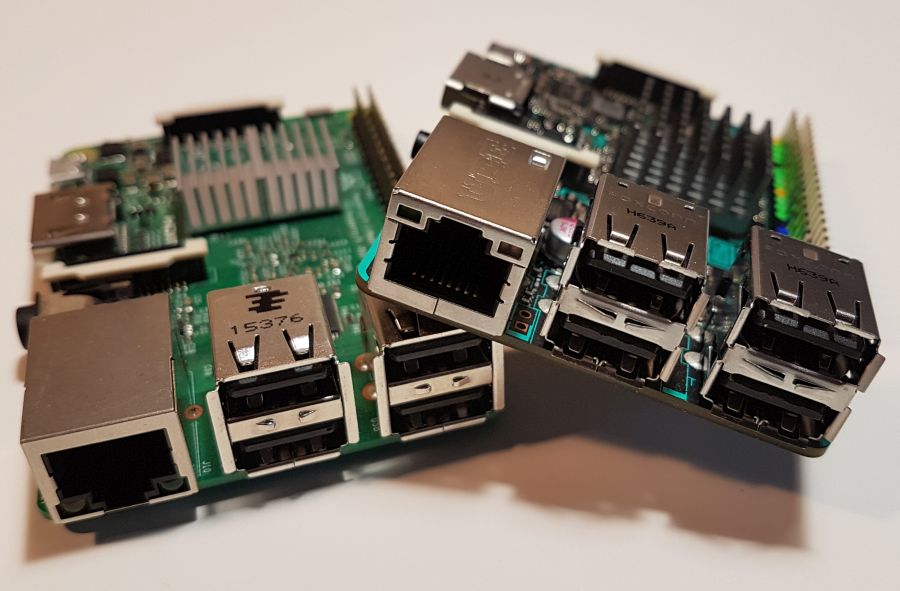
According to the specifications, the Tinker Board is more powerful than the Raspberry Pi 3. Let’s see if it’s true with several CPU/GPU benchmarks.
Hardware / Software details:
– HW: Tinker Board rev 1.2, default clock speed – SW: Tinker OS 2.0.4
– HW: Raspberry Pi 3 Model B v1.2, default clock speed – SW: Raspbian Stretch (v2017-11-29)
1 – CPU Benchmark
1.1 – Sysbench
To benchmark the CPU, I used Sysbench 0.4.12, a cross-platform and multi-threaded benchmark tool. The installation of Sysbench on Tinker OS and Raspbian is rather easy:
$ sudo apt-get install sysbench
Now that Sysbench is installed, we can launch the multi-threaded (4 threads) CPU test with:
$ sysbench --test=cpu --cpu-max-prime=20000 --num-threads=4 run
| 65 seconds – Tinker Board (default clock speed) – Tinker OS 2.0.4 |
| 96 seconds – Raspberry Pi 3 (default clock speed) – Raspbian Stretch |
Rule for these scores: lower is faster.
The output of Sysbench for the Tinker Board is:
sysbench 0.4.12: multi-threaded system evaluation benchmark
Running the test with following options:
Number of threads: 4
Doing CPU performance benchmark
Threads started!
Done.
Maximum prime number checked in CPU test: 20000
Test execution summary:
total time: 65.0652s
total number of events: 10000
total time taken by event execution: 260.1871
per-request statistics:
min: 25.10ms
avg: 26.02ms
max: 86.35ms
approx. 95 percentile: 28.23ms
Threads fairness:
events (avg/stddev): 2500.0000/30.69
execution time (avg/stddev): 65.0468/0.01
1.2 – LLVMPIPE Software Renderer
For this second multi-threaded CPU bench, I used GeeXLab with the LLVMPIPE software rasterizer. LLVMPIPE is a multi-threaded and highly optimized software rasterizer (more info HERE). On the Tinker Board, you have have access to that software renderer if you use GeeXLab with OpenGL desktop. On the Raspberry Pi 3, you have to disable the OpenGL desktop support (raspi-config can help) and use this version of GeeXLab.
I selected the following shadertoy demo that runs in software mode on both Tinker Board and Raspberry Pi 3. This demo is shipped with GeeXLab and you can find it in the demos folder (demos/shadertoy/09-noise-animation-electric.xml). The resolution is 600×380 which is more than enough for our little SBCs! On both SBCs, the CPU usage is near 100%.
Both boards have the OpenGL renderer:
GL_RENDERER: Gallium 0.4 on llvmpipe (LLVM 3.9, 128 bits)

| 7 FPS – Tinker Board (default clock speed) – Tinker OS 2.0.4 |
| 1 FPS – Raspberry Pi 3 (default clock speed) – Raspbian Stretch |
Rule for these scores: higher is faster.
2 – GPU Benchmark
For the GPU benchmark, I used GeeXLab with the OpenGL ES renderer because on both boards, OpenGL ES is hardware accelerated. For the Tinker Board, you can use this version of GeeXLab. On the Raspberry Pi 3 with Raspbian Stretch, you can use this version of GeeXLab.
I launched the same shadertoy than for the CPU benchmark, the only difference is the resolution: 1280×720.
On both boards, the CPU usage is very low (less than 3%).


| 30 FPS – Tinker Board (default clock speed) – Tinker OS 2.0.4 |
| 19 FPS – Raspberry Pi 3 (default clock speed) – Raspbian Stretch |
Rule for these scores: higher is faster.
3 – Conclusion
What can I say? The Tinker Board is faster than the Raspberry Pi 3, no doubt on that fact. The CPU is faster, the GPU is faster.

Nice article!
Do you have access to this, for comparison?
https://www.amazon.com/Firefly-RK3399-Computer-Reference-Development/dp/B06XSCT11S/ref=sr_1_4?ie=UTF8&qid=1515878697&sr=8-4&keywords=rk3399
Firefly RK3399 Plus Single Board Computer Reference Kit for Open Source Development (4GB RAM 32GB eMMC)
Nice comparison, thank you!
Thanks to your review post about the Tinker Board, I now own one as well 🙂 But I was initially pretty disappointed with the render performance of my applications under X11 + TinkerOS 2.0.4. This chip should be capable of so much more…
So I did some research, and am now running https://www.armbian.com/ and after following the instructions in this post ( https://forum.armbian.com/topic/5416-gpu-driver/?do=findComment&comment=43003 ) and using SDL + its DRM back-end without X11, this baby is FLYING now! So happy with how it performs now, it’s like day + night!
Thought you might find that interesting!
Thanks for the armbian link. It’s nice to see there is an active ecosystem around these kind of boards.
Interestingly, I have a RRi 3 B+ which is installed by Ubuntu 18.04.01 arm64. And it shows great performance than 32-bit based Raspbian
CPU speed:
events per second: 931.26
General statistics:
total time: 10.0040s
total number of events: 9322
Latency (ms):
min: 4.24
avg: 4.29
max: 16.29
95th percentile: 4.33
sum: 40001.69
Threads fairness:
events (avg/stddev): 2330.5000/11.08
execution time (avg/stddev): 10.0004/0.00